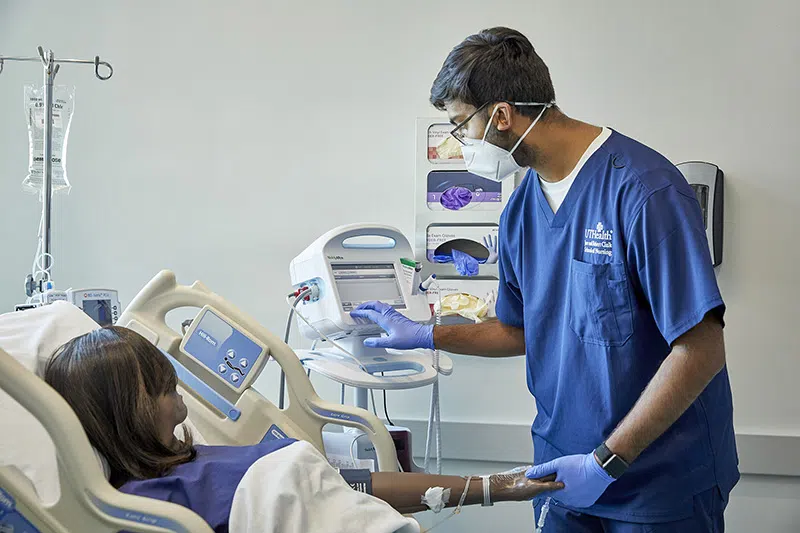POLICY
Expanded access is a potential pathway for patients with a serious or immediately life-threatening disease or condition to gain access to an investigational drug or biological product (i.e., a product that has not been approved or cleared by FDA) when no comparable or satisfactory alternative therapy options are available; the potential patient benefits justify the potential risks to the patient; and the requested use will not interfere with clinical investigations that could support marketing approval (21 CFR 312.305(a)).
Approval by the IRB (by full board or by concurrence of an IRB chairperson), as well as approval or authorization by FDA, must be obtained prior to expanded access use of an investigational drug or biological product to treat a patient (for either emergency or non-emergency use).
Key Terms
Expanded access is a potential pathway for patients with a serious or immediately life-threatening disease or condition to gain access to an investigational drug or biological product (i.e., a product that has not been approved or cleared by FDA) when no comparable or satisfactory alternative therapy options are available; the potential patient benefits justify the potential risks to the patient; and the requested use will not interfere with clinical investigations that could support marketing approval (21 CFR 312.305(a)). The primary purpose of individual patient expanded access is to diagnose, monitor, or treat a patient’s disease or condition, and expanded access use is outside of clinical trials and is not intended to obtain information about the safety or effectiveness of the drug, biological product, or medical device. Expanded access is sometimes informally called “compassionate use”; however, this term is not defined or described in the FDA regulations.
Immediately life threatening disease or condition for the purposes of 21 CFR 312 Subpart I (the regulation on expanded access to investigational drugs for treatment use) means a stage of disease in which there is reasonable likelihood that death will occur within a matter of months or in which premature death is likely without early treatment (21 CFR 312.300).
Serious disease or condition for the purposes of 21 CFR 312 Subpart I means a disease or condition associated with morbidity that has substantial impact on day-to-day functioning. Short-lived and self-limiting morbidity will usually not be sufficient, but the morbidity need not be irreversible, provided it is persistent or recurrent (21 CFR 312.300). Whether a disease or condition is serious is a matter of clinical judgment, based on its impact on such factors as survival, day-to-day functioning, or the likelihood that the disease, if left untreated, will progress from a less severe condition to a more serious one (21 CFR 312.300).
Expanded access for emergency use is a subset of expanded access where there is an emergency that requires the patient to be treated with an investigational drug before a written submission can be made to FDA (21 CFR 312.310(d)).
Emergency use for the purposes of 21 CFR 56.104(c) (the regulation on exemption from prior IRB approval for emergency use) means the use of an investigational drug or biological product in a human subject in a life-threatening situation in which no standard acceptable treatment is available and in which there is not sufficient time to obtain IRB approval (21 CFR 56.102(d)). Life-threatening for the purposes of 21 CFR 56.104(c) includes the scope of both life-threatening and severely debilitating. Note that this policy requires that the physician receive IRB approval (by full board or by concurrence of an IRB chairperson) before starting emergency use expanded access treatment.
Life-threatening for the purposes of 21 CFR 56.104(c) and 21 CFR 56.102(d) means diseases or conditions where the likelihood of death is high unless the course of the disease is interrupted and diseases or conditions with potentially fatal outcomes. The condition does not need to be immediately life-threatening or to immediately result in death. Rather, the subjects must be in a life-threatening situation requiring intervention before the IRB has the ability to review the use at a convened meeting.
Severely debilitating for the purposes of 21 CFR 56.104(c) and 21 CFR 56.102(d) means diseases or conditions that cause major irreversible morbidity. Examples of severely debilitating conditions include blindness; loss of arm, leg, hand or foot; loss of hearing; paralysis; or stroke.
PROCEDURE
If a situation arises necessitating the use of an investigational drug in a single patient, wherever possible, use of an investigational medical product by a patient as part of a clinical trial is preferable, and the treating physician should determine if an active protocol is available and if the patient meets the eligibility criteria. However, when patient enrollment in a clinical trial is not possible (e.g., a patient is not eligible for any ongoing clinical trials, or there are no ongoing clinical trials), patients may be able to receive the investigational product, when appropriate, through expanded access. The treating physician should contact the manufacturer of the investigational drug or biological product to determine if the product can be made available through expanded access.
The categories of expanded access are individual patient (also called single patient) expanded access for either emergency or non-emergency use, intermediate-size patient population expanded access, and treatment expanded access for widespread use. Intermediate-size patient population expanded access and treatment protocols are reviewed by the usual IRB procedures outlined in the policy on initial review. Procedures for IRB review of individual patient expanded access to investigational drugs or biological products (for either emergency or non-emergency use) are described in this policy.
FDA Review of Individual Patient Expanded Access to an Investigational Drug or Biological Product: There are two mechanisms for submission to FDA:
- an expanded access protocol submitted as a protocol amendment to an existing IND (i.e., an expanded access protocol). An expanded access protocol submission should be used only if the person or entity seeking the expanded access has an existing IND in effect.
- a new IND submission, which is separate and distinct from any existing INDs and is intended only to make a drug available for treatment use (i.e., an expanded access IND). A new expanded access IND submission should be used when there is no existing IND in effect for the drug or, more commonly, there is an existing IND in effect for the drug, but the sponsor of the existing IND declines to be the sponsor of the expanded access use (that is, for an individual patient use, the sponsor of the existing IND may prefer that a patient’s physician submit a separate individual patient IND).
FDA in their review determines that the patient to be treated has a serious or immediately life-threatening disease or condition, and there is no comparable or satisfactory alternative therapy to diagnose, monitor, or treat the disease or condition; the potential patient benefit justifies the potential risks of the treatment use and those potential risks are not unreasonable in the context of the disease or condition to be treated; the patient cannot obtain the drug under another IND or protocol; and providing the investigational drug for the requested use will not interfere with the initiation, conduct, or completion of clinical investigations that could support marketing approval of the expanded access use or otherwise compromise the potential development of the expanded access use.
Individual patient expanded access IND: Unless FDA notifies the patient’s physician or the sponsor that treatment may begin earlier, there is a 30-day period from the date FDA receives the IND application before treatment with the drug may begin (unless the IND is put on clinical hold). FDA requires IRB review and approval before the expanded access use may begin.
Individual patient expanded access IND for emergency use (sometimes called “eIND”): Treatment is initially requested and authorized by telephone (or other rapid means of communication) and may start immediately upon FDA authorization, and the physician or sponsor must agree to submit a written submission (IND) within 15 working days of the initial authorization.
Individual patient expanded access protocol: There is no 30-day period before treatment with the drug may begin, but the protocol must be submitted to FDA and have IRB approval before the expanded access treatment may begin.
Individual patient expanded access protocol for emergency use: Treatment is initially requested and authorized by telephone (or other rapid means of communication) and may start immediately upon FDA authorization, with a requirement for a written submission (protocol) to FDA within 15 working days of the initial authorization.
IRB Review of Individual Patient Expanded Access to an Investigational Drug or Biological Product: A physician submitting an individual patient expanded access IND using Form FDA 3926 may select the appropriate box on that form to request a waiver under of the requirements for full IRB review. Such a waiver is appropriate for individual patient expanded access INDs when the physician obtains concurrence by the IRB chairperson or another designated IRB member before treatment use begins. A physician submitting an individual patient expanded access IND using Form FDA 1571 may include a separate waiver request with the application.
The information reviewed by the IRB must be adequate to assess whether risks to the patient have been minimized and that such risks are reasonable in relation to anticipated benefits in the context of an individual patient expanded access request. The treating physician should submit the following information to the IRB office by email to cphs@uth.tmc.edu for emergency use and via iRIS for non emergency use:
- Completed Form FDA 3926 or a letter (or a protocol if available) that includes an explanation of the conditions supporting the determination that the patient is in a serious or life-threatening condition that needs immediate treatment, that there is no comparable or satisfactory alternative treatment, and that the probable risk to the person from the investigational drug is not greater than the probable risk from the disease or condition, as well as a request to waive the requirement for full IRB review). The following information should be included either in the FDA 3926 or separate letter:
- A thorough patient history and treatment plan.
- The proposed daily dose, route, and frequency of administration, duration of planned treatment, criteria for discontinuation of treatment, and planned dose modifications for adverse events;
- The planned monitoring for adverse events, response to treatment, and changes in clinical status, as well as proposed modifications to the treatment plan to mitigate risks to patients if appropriate;
- The key details of the patient’s history, including diagnosis and summary of prior therapy (including response to such therapy), as well as information regarding a patient’s relevant clinical characteristics (such as comorbid conditions and concomitant medications) that are necessary to assess the potential for increased risks of the drug; and
- A summary of known risks of the drug.
- A simple informed consent document or justification for waiver of consent.
- A letter of authorization from the sponsor or manufacturer to allow the expanded access use of the investigational drug or biological product by the treating physician.
- Documentation of an FDA-approved Individual Patient Expanded Access IND, if available.
The IRB director will assign the review of the submitted materials to an IRB chairperson or another designated IRB member for review. The IRB reviewer may seek additional information or clarification from the treating physician. When reviewing individual patient expanded access requests for investigational drugs and biological products, the IRB chair or designated reviewer will consider the following:
- Focus the review of an expanded access request for an individual patient on assessing the risks and benefits of treatment with the investigational drug or biological product for the patient involved.
- Assess the qualifications of the physician submitting the individual patient expanded access request.
- When the request is for a pediatric patient, confirm that adequate provisions are included for soliciting age-appropriate assent from children and permission from a parent or guardian.
- Confirm that the informed consent document contains the information required under the policy on informed consent. The consent form should contain a statement indicating that although the primary use of the drug is for treatment, the drug is investigational and FDA has not determined that the drug is safe or effective.
If the IRB chairperson agrees with the treating physician’s determination that treatment of the patient with the investigational drug or device is warranted, then the IRB office will issue a letter with the determination that the situation meets the FDA regulatory requirements for individual patient expanded access use of the investigational drug or biological product.
Informed Consent: The treating physician must obtain informed consent of the subject or the subject's legally authorized representative, unless waived. The requirement for informed consent may be waived by the IRB chairperson if the criteria listed below are met. The treating physician and a physician who is not otherwise participating in the treatment of the subject shall certify in writing the following criteria:
- The patient is confronted by a life-threatening and/ or severely debilitating situation necessitating the use of the investigational drug or biological product;
- Informed consent cannot be obtained because of an inability to communicate with, or obtain legally effective consent from, the patient;
- Time is not sufficient to obtain consent from the patient’s legal representative; and
- No alternative method of approved or generally recognized therapy is available that provides an equal or greater likelihood of saving the patient’s life.
If, in the treating physician’s opinion, immediate use of the test article is required to preserve the patient’s life, and if time is not sufficient to obtain an independent physician’s determination that the four conditions listed above apply, then the treating physician should make the determination and, within five working days after the use, have the determination reviewed and evaluated in writing by a physician who is not otherwise participating in the treatment of the subject.
Reporting:
- IRB Reporting: The treating physician must submit a written follow-up report to the IRB within 2 weeks of use of the investigational product. This report should include:
- Name of the investigational drug;
- Conditions under which the investigational drug was administered;
- Date and time administered;
- Any adverse events or unanticipated problems to recipient or others; and
- Outcomes, if known.
- FDA Reporting: As with any IND, the expanded access IND holder must submit safety reports and annual reports (when the expanded access IND or protocol continues for 1 year or longer) to FDA. For individual patient expanded access, at the conclusion of treatment, the expanded access IND holder must provide to FDA a written summary of the results of the expanded access use, including adverse effects. With respect to reporting serious and unexpected adverse reactions in FDA IND safety reports, the expanded access IND holder must report an adverse event as a suspected adverse reaction only if there is evidence to suggest a causal relationship between the drug and the adverse event.
APPLICABLE REGULATIONS AND GUIDANCE
- 21 CFR 312 Subpart I: Expanded Access to Investigational Drugs for Treatment Use
- 21 CFR 56.104 – Exemption from IRB Requirement for Emergency Use
- FDA Guidance - Expanded Access to Investigational Drugs for Treatment Use-Questions and Answers - Oct 2017
- FDA Guidance - Institutional Review Board (IRB) Review of Individual Patient Expanded Access Requests for Investigational Drugs and Biological Products During the COVID-19 Public Health Emergency. June 2020
- FDA Guidance: Emergency Use of an Investigational Drug or Biologic
- Individual Patient Expanded Access Applications: Form FDA 3926
- Expanded Access How to Submit a Request (Forms)
- Emergency IND Timeline
- Expanded Access Categories for Drugs (Including Biologics) – Jan 2018
REFERENCES TO OTHER POLICIES
- Initial Review
REFERENCES TO OTHER SOP
- None
ATTACHMENTS
- None
If you find errors in this document, contact clinicaltrials@uth.tmc.edu
|
Document Number:
|
101-D04
|
|
Document Name:
|
Individual Patient Expanded Access
|
|
Reviewed by:
|
Executive Director, Research Compliance
|
|
Effective:
|
1 Aug 2008
|
|
Revision History:
|
1 Aug 2011, 1 Jun 2016, 21 Jan 2019, 1 Jun 2021
|










